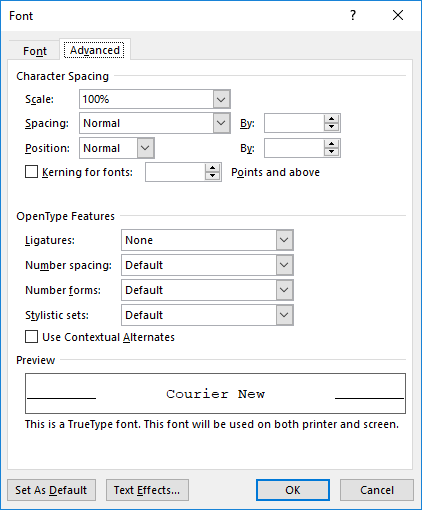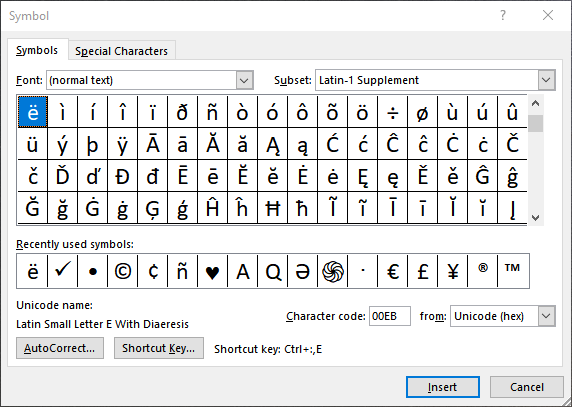Please Note: This article is written for users of the following Microsoft Word versions: 2007, 2010, 2013, 2016, 2019, 2021, and Word in Microsoft 365. If you are using an earlier version (Word 2003 or earlier), this tip may not work for you. For a version of this tip written specifically for earlier versions of Word, click here: Non-breaking Em Dashes.
Written by Allen Wyatt (last updated October 14, 2023)
This tip applies to Word 2007, 2010, 2013, 2016, 2019, 2021, and Word in Microsoft 365
Word allows you to enter many different typographical symbols, among them en dashes and em dashes. Exactly how you create these types of dashes has been covered in other issues of WordTips. However, it should be noted that an em dash may not work exactly as you want it to. Normally an em dash is placed in a document between two words. In other words, there are typically no spaces around an em dash. (An en dash may be a different story that we won't get into in this tip.)
For those readers who are editors and/or typographers, a quick side-trip may be in order here. (For those who don't fall into this category, please excuse this tangent, but I know from sad experience that debating punctuation can be a somewhat religious experience.) Some of you may take exception to the claim of no surrounding spaces. Just so you know, I am relying on The Chicago Manual of Style for my reference here. It indicates that a space may precede or follow (but not precede and follow) a 2-em dash to indicate missing letters, or spaces can appear on both sides of a 3-em dash to indicate missing words. Both of those instances are beyond the scope of this tip; here we are talking about single em dashes.
Meanwhile, back in Word-land, an em dash is always sticky to the word it follows. Thus, in the phrase "John—the original author—was flabbergasted," the em dashes will always stay with the words John and author as the end of a line is reached. In this way, an em dash can appear as the last character on a line, but never as the first character on a line.
If you want your em dashes to be sticky on both ends (sort of like a very long non-breaking hyphen), then you may be out of luck. Many people get around the problem by putting two, three, or even four non-breaking hyphens in a row to simulate a non-breaking em dash. The problem with this solution is that the non-breaking hyphens end up looking like a dashed line, not a solid em dash. You can minimize or virtually eliminate the natural spaces between the non-breaking hyphens by following these steps:

Figure 1. The Advanced tab of the Font dialog box.
The result is four characters (all non-breaking hyphens) that appear as a single character since they basically overprint each other just a bit. You can also take these four characters and assign them to an AutoText or AutoCorrect entry so they will be easy to use in the future.
You can also take a little different approach to the issue: You can stretch characters instead of condensing spacing. If you want to take this approach, simply insert a single non-breaking hyphen between your words, then follow these steps:
Finally, you can insert a symbol to use instead of the regular em dash used by Word. This symbol will be sticky on both ends, unlike the em dash. Follow these steps:

Figure 2. The Symbol dialog box.
With all these potential solutions, there is one caveat of which you should be aware. The spelling and grammar checkers in Word know how to handle the regular em dash; they don't know how to handle these workarounds. Thus, don't be surprised if one of the checkers treats the word-dash-word combination as a single word and flags it as incorrect. (Just a little warning so you don't rely on Word to catch your spelling errors in this instance.)
WordTips is your source for cost-effective Microsoft Word training. (Microsoft Word is the most popular word processing software in the world.) This tip (2080) applies to Microsoft Word 2007, 2010, 2013, 2016, 2019, 2021, and Word in Microsoft 365. You can find a version of this tip for the older menu interface of Word here: Non-breaking Em Dashes.

Learning Made Easy! Quickly teach yourself how to format, publish, and share your content using Word 2021 or Microsoft 365. With Step by Step, you set the pace, building and practicing the skills you need, just when you need them! Check out Microsoft Word Step by Step today!
Need a special character (such as a bullet) in the middle of your text? Here are two quick ways to enter the character ...
Discover MoreWant a little more space just before some of your punctuation characters? You can add that spacing in a variety of ways, ...
Discover MoreSometimes typing isn't straight typing. Sometimes you need to perform special tasks, such as putting dashes between ...
Discover MoreFREE SERVICE: Get tips like this every week in WordTips, a free productivity newsletter. Enter your address and click "Subscribe."
2024-01-10 21:28:31
Ray P....
What sort order does Windows apply to 0150 & 0151? I cannot seem to get consistent results. For
0151=these i.e.: —=these and 0150=those i.e.: –=those
I would expect "0150=those" to appear before "0151=these" like this:
0150=those i.e.: –=those
0151=these i.e.: —=these
But so far in actual files the words these & those seem to dominate.
Does Windows do something odd for these two glyphs?l
2023-10-18 15:17:04
Craig Harbuck
Suggestions for VBA code to insert bookmarks for specific content passages that can then be iterated over to copy each passage to insert in associated field in an Access database table. The hard part seems to be writing regular expressions that can find and select each specific content passage. The goal is to insert content of a large document using code instead of manually copying and pasting each passage.
2023-10-16 10:18:15
Andrew
These are all delightful solutions to the issue! Thanks.
I would only add:
• In the multiple-hyphen scenario, the condensing property should NOT be applied to the final hyphen, which draws it up too close to the following letter and looks bad, and the 1.2 pt condensing factor may need to be adjusted based on font and/or font size.
• In the Horizontal Bar Scenario, the bar seems to be placed too high, and moving it messes up with the paragraph line spacing, so I'll stick with the hyphen solutions.
• In any of these scenarios, how do we make the resulting line thinner?
Andy.
2023-10-14 19:11:46
Ray McAllister
This seems much more complex than necessary. To make the em dash “stick” to the word that follows, insert a special character “No-Width Non Break” immediately following the em dash. This should not affect spell checking of the word that follows.
Got a version of Word that uses the ribbon interface (Word 2007 or later)? This site is for you! If you use an earlier version of Word, visit our WordTips site focusing on the menu interface.
Visit the WordTips channel on YouTube
FREE SERVICE: Get tips like this every week in WordTips, a free productivity newsletter. Enter your address and click "Subscribe."
Copyright © 2026 Sharon Parq Associates, Inc.
Comments